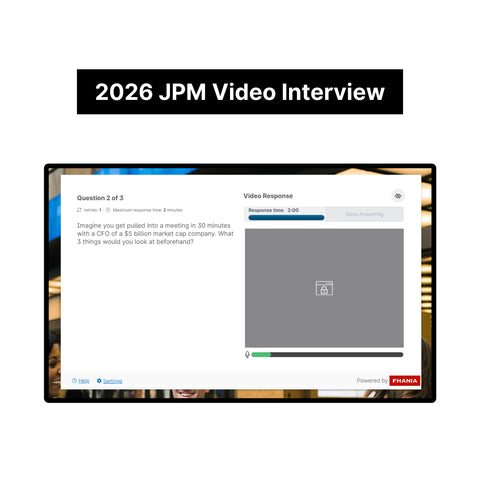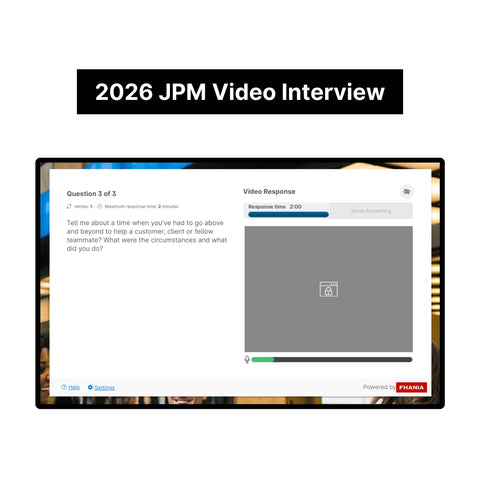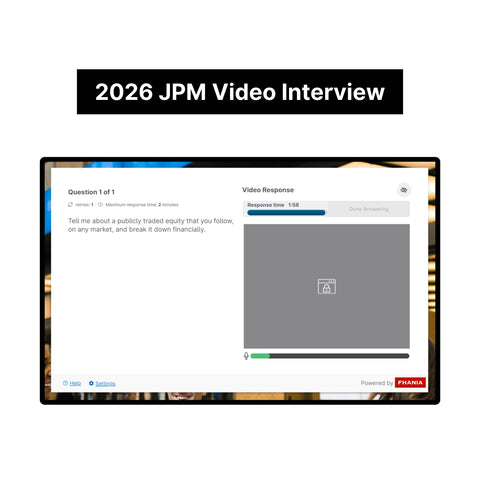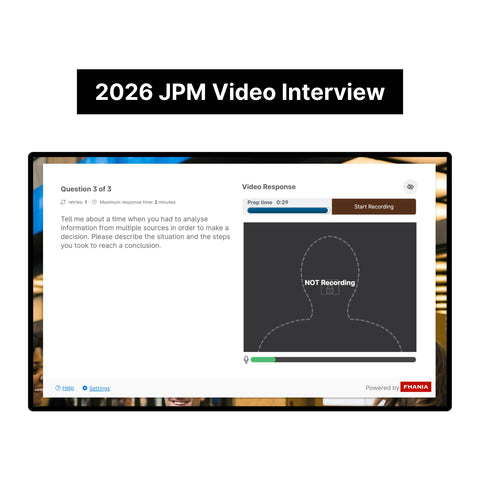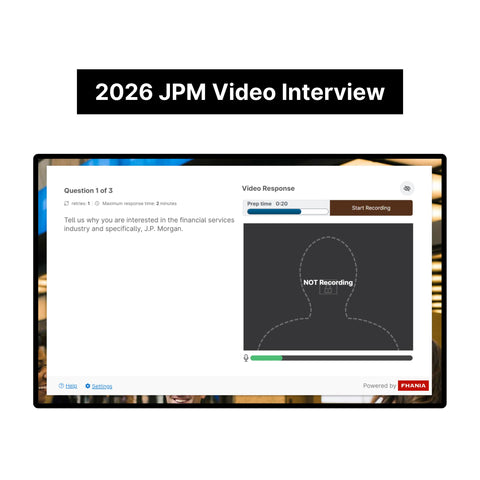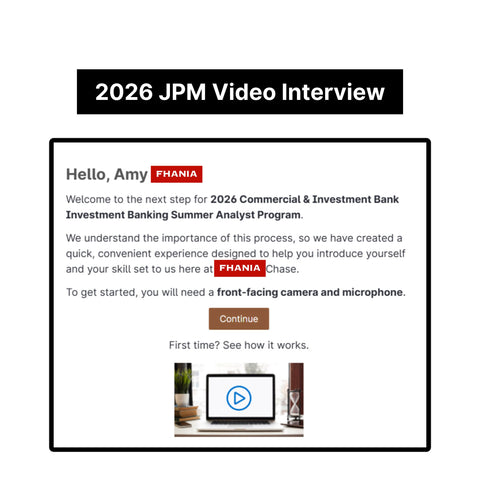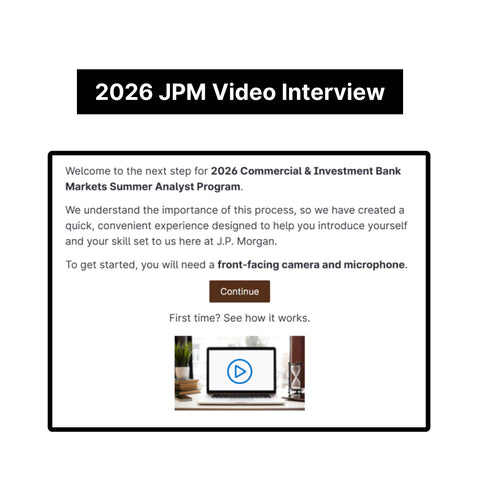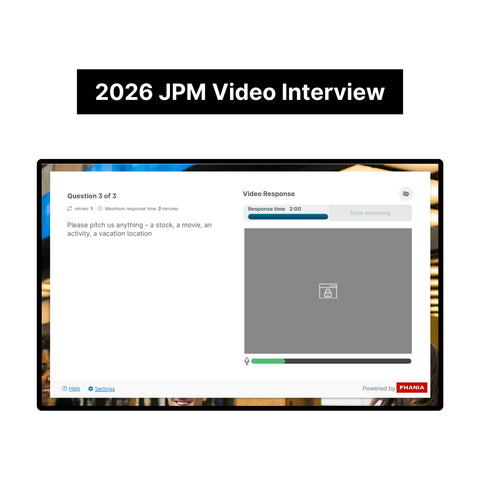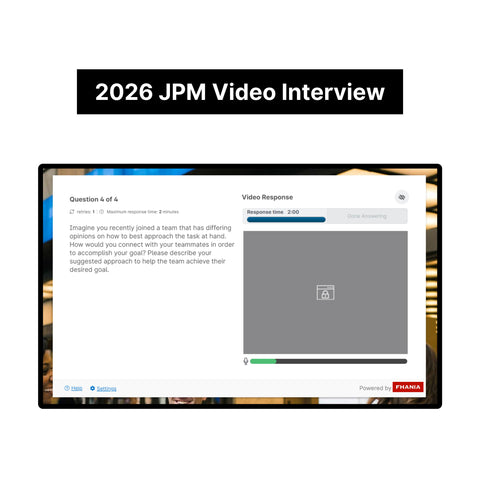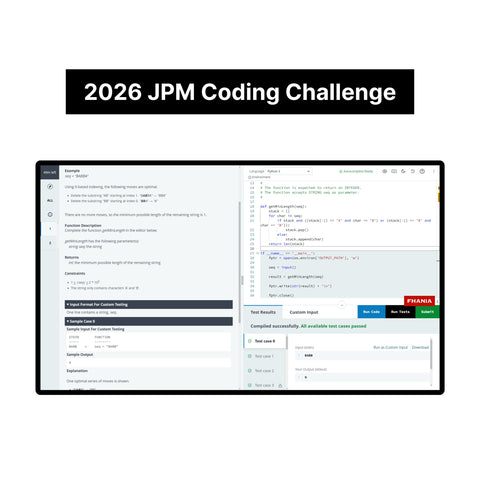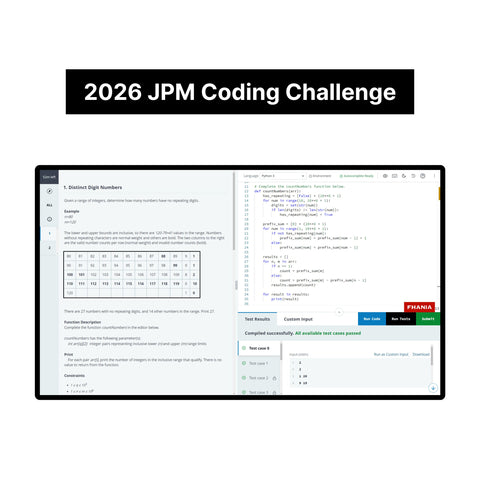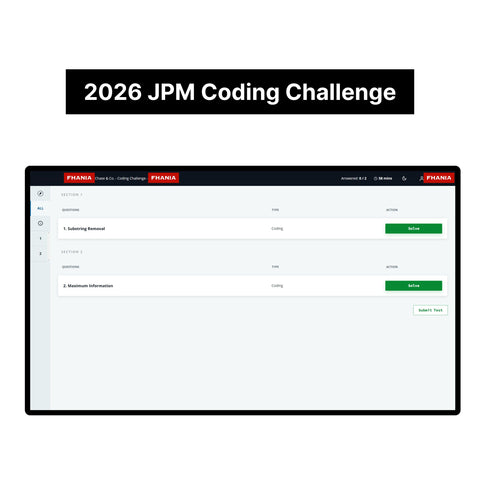Offer
2026 JP Morgan Commercial & Investment Bank – Investment Banking Summer Analyst HireVue: The “Local Laundromat Valuation” Question That Makes 2026 the Toughest Year on Record
For the first time in program history, JP Morgan’s Commercial & Investment Bank has compressed its HireVue into a single 90-second prompt. The question sounds harmless—“You’ve been asked to advise your local laundromat on a potential sale. How would you value the business?”—yet it is already eliminating candidates who underestimate its depth.
This guide explains why the 2026 format is brutally difficult, offers a five-step framework that actually fits the timer, walks through two complete sample answers, and shows where to get a proven answer kit so you can record with confidence instead of guesswork.
1 · Anatomy of the 2026 HireVue Challenge
Last year candidates faced three to four two-minute questions and enjoyed three retries per prompt. In 2026 there is only one 90-second video. Topic range shifts from generic motivation chat to a live valuation case, and the scoring algorithm now tracks judgment, mental math, and camera poise. One pause or tangent can end your run.
- No warm-up – you dive straight into valuation.
- Zero margin for error – a single freeze can disqualify you.
- AI grades eye-line, pacing, filler-word density, and content coverage.
- Ninety seconds to land every point – time poverty at its worst.
2 · Breaking Down the Prompt
Valuing a neighbourhood laundromat at speed is trickier than it looks:
- Revenue fragments across machine cycles, wash-and-fold, detergent sales, lockers, even ATM fees.
- The books are largely cash and rarely audited.
- Owned versus leased property swings valuation multiples.
- Mistiming 10- to 15-year cap-ex on industrial washers skews EBITDA.
Key insight: JP Morgan does not need perfect numbers; they want to hear which assumptions you surface and how you converge on a defensible range.
3 · The 90-Second, Five-Step Framework
- Clarify (10 s) — confirm you are valuing equity and will treat real estate separately.
- Rebuild revenue (15 s) — machine cycles × price, then add ancillary streams.
- Normalise cash (20 s) — strip one-offs; set maintenance cap-ex ≈ depreciation.
- Triangulate value (25 s) — blend EBITDA multiple, quick DCF, and asset check.
- State range (20 s) — “about $550–650 k for ops plus $300 k property; kiosks are upside, a new rival is downside.”
Delivered cleanly, those five sentences consume 90 seconds and satisfy every rubric the algorithm measures.
4 · Sample Answer #1 — Pragmatic Banker
Thanks for the question. I’ll value the laundromat on a standalone operating basis and add or subtract property value if the owner holds the building. A 30-machine shop running 8 am – 10 pm averages about five turns a day; at $4 per wash and $4.50 per dry that’s roughly $1.08 k daily, or $395 k annually. I’d sanity-check those numbers against smart-meter electricity data, which shadows machine hours even when receipts are cash. Ancillary sales — mainly wash-and-fold, detergent vending, and ATM fees — add about twelve percent, pushing top-line revenue to roughly $440 k. Utilities in this zip code run sixteen percent of sales; rent on 2 000 sq ft at $25 triple-net is $50 k; labour for two attendants totals $60 k; maintenance $25 k; insurance \$15 k. EBITDA lands near \$190 k, and after normalised maintenance cap-ex free cash flow sits at roughly \$155 k. For valuation I triangulate three ways. First, market comps: recent SBA-financed laundromat deals clear 5.5–6.5 × EBITDA, so I anchor at six times, implying about \$930 k for operations. Second, a conservative flat-growth DCF using an 8 percent WACC and 2 percent terminal growth gives an enterprise value of ~\$1.7 m with property included. Third, an asset rebuild: replacement cost of machines is \$350 k less forty-percent depreciation plus working capital, or about \$230 k. Weighting 50 percent multiple, 40 percent DCF, and 10 percent asset I arrive at \$1.0–1.1 m for the going concern. If the seller also owns the real estate, fair-market is around \$400 k, bringing equity value to roughly \$1.5 m. I then adjust ten percent downward for end-of-life equipment risk or five percent upward if zoning locks out competitors. My advised negotiating band is \$1.35–1.65 m.
5 · Sample Answer #2 — Technical Edge
I treat the laundromat as an annuity-like utility with equipment beta and property optionality. Twenty-eight washers and twenty-four dryers turning 4.8 cycles at a \$4.25 median price yield about \$418 k gross. Utility load curves confirm honest reporting and show variable power costs at eighteen percent of revenue, leaving a seventy-percent gross margin. With \$85 k rent, \$40 k labour, and \$28 k maintenance, EBITDA is \$141 k. Washers depreciate over twelve years and dryers over fifteen, so I reserve \$34 k a year for replacement, bringing unlevered FCF to \$107 k. Capitalised at a nine-percent private-market return with one-percent perpetual growth, enterprise value is \$1.31 m. Adjacency matters: third-party locker drop-off is growing at a 22 percent three-year CAGR in comparable zip codes. Four lockers at \$3 k each with a six-percent attach rate by year three add roughly \$16 k EBITDA and \$120 k value at a seven-times multiple; risk-adjusting at sixty percent probability contributes \$70 k to point estimate. Comps support the DCF: BizBuySell regional data show median 6.2 × EBITDA for urban coin-ops with locker service, aligning to \$875 k base. Averaging \$875 k, \$1.31 m, and \$70 k yields about \$1.1 m for operations. If the seller owns real estate, a seven-percent cap on 2 100 sq ft at \$26 NNN rents values property at \$372 k, bringing total equity to roughly \$1.45 m. I deliver a three-scenario table — base, downside (five-percent traffic erosion), and upside (locker expansion) — plus a utility-inflation sensitivity matrix so the client can negotiate from a disciplined cash-flow view.
6 · Turning Anxiety into Advantage
Rehearse with a real 90-second timer until every sentence fits. Internalise the framework, not a script. Drill mental math on multiples, discount rates, and terminal values. Keep a steady eye-line — the algorithm measures gaze stability. Need a shortcut? The JP Morgan HireVue Answer Kit contains your exact prompts, pacing drills, and banker-approved scripts used by successful candidates.
Final Thoughts
The 2026 JP Morgan HireVue is engineered to expose shaky fundamentals in ninety seconds. Arrive with a clear structure, practise until you sound conversational, and you can turn a stress test into a personal highlight reel.



